#Genre: Roots Reggae Reggae
Explore tagged Tumblr posts
Text
Bob Marley & The Wailers - Buffalo Soldier
#Bob Marley & The Wailers#Confrontation#Buffalo Soldier#Format:#Vinyl#LP#Album#Stereo#Gatefold#Country:#Europe#Released:#1983#Genre:#Reggae#Style:#Roots Reggae#Jamaica
16 notes
·
View notes
Text
Jamaican Sound Clash Culture
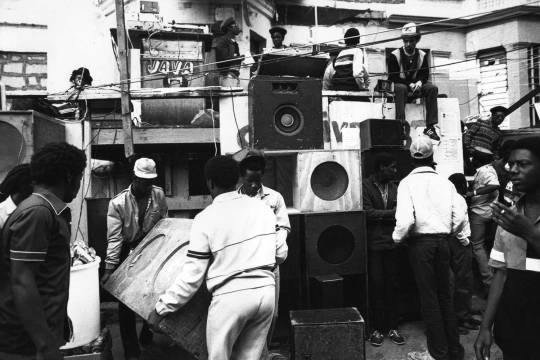
Jamaican sound clash culture has its roots in the 1950s and 1960s, when sound systems first began to emerge in Jamaica. These sound systems were essentially mobile DJ setups that would play music at outdoor parties, dances, and other events. They were an important part of the local music scene, and helped to popularize a variety of different genres, including ska, rocksteady, and reggae.
As the popularity of sound systems grew, so too did their competitiveness. DJs and sound system operators began to engage in battles or "clashes" where they would compete against one another to see who had the best music selection, sound quality, and overall performance. These clashes often took place in outdoor venues and were attended by large crowds of people who would dance and cheer on their favorite sound systems.
In the 1970s, sound clash culture really took off in Jamaica, as a new generation of sound system operators emerged, including some of the most famous names in the business, such as King Tubby, Duke Reid, and Coxsone Dodd. These sound systems were known for their powerful sound systems, huge music collections, and their ability to engage in quick-witted banter and insults, known as "dubplate specials."

During this time, sound clash battles became more intense and competitive, with sound system operators often spending large sums of money on rare and exclusive records and dubplates in order to gain an edge over their rivals. These battles became a major part of Jamaican culture, with fans and enthusiasts following their favorite sound systems and DJs around the country to attend clashes and other events.
In the 1980s, sound clash culture began to spread beyond Jamaica and into other parts of the world, as Jamaican immigrants brought the tradition with them to cities like New York, London, and Toronto. Today, sound clash culture continues to thrive in Jamaica and around the world, with new generations of sound system operators and DJs carrying on the tradition and keeping the spirit of competition and creativity alive.
youtube
The rivalry between sound systems is intense and the rules dictate that only exclusive dubplates are played, which are usually rare or specifically cut for the clash. These dubplates are unique cuts of certain popular tunes or other material. Watching a sound clash is good fun and the audience decides who is better by cheering the most, and the energy is usually insane. In this case, Rodigan acts as both his own DJ and MC, but sometimes other MCs are present and the selecta (DJ) is separate. In Jamaica, the MCs are called deejays and the DJs are called selectas. Sometimes there are even special dancers on stage to make the show even more energetic. Sound systems in Jamaica were popular because people couldn't afford to buy records or speakers, so they would play music in the streets for everyday people. Then, they began to develop a rivalry and a following. It got crazy in the 80s when dancehall became harder and more violent in its lyrics. The sound clash is all about who has the best records, rarest collection, and most unique dubplates cut by artists. The artists usually voice a special message into the dubplates, hyping up the selecta/sound system. Hip hop may have also copied some of this culture, but it's not clear whether it developed on its own or was copied from Jamaica.
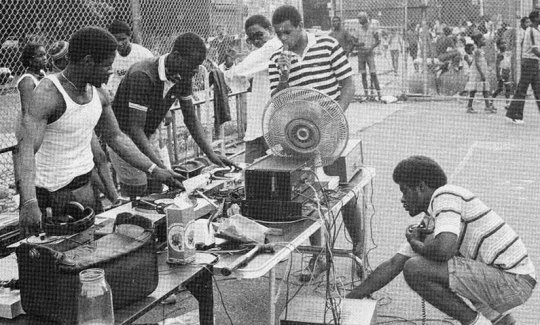
195 notes
·
View notes
Text

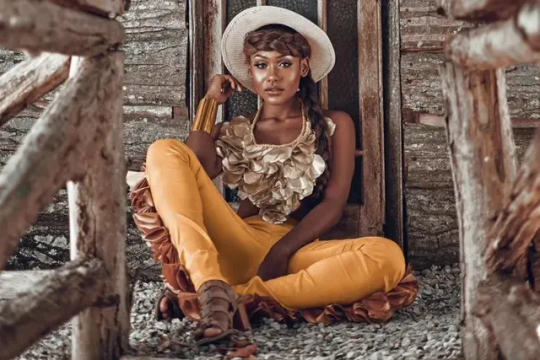
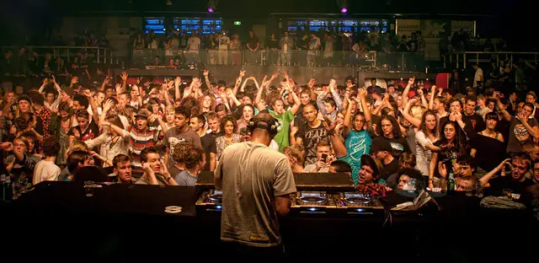
In Jamaican dancehall music, a riddim is the instrumental accompaniment to a song and is synonymous with the rhythm section. Jamaican music genres that use the term consist of the riddim plus the voicing (vocal part) sung by the deejay. A given riddim, if popular, may be used in dozens—or even hundreds—of songs, not only in recordings but also in live performances.
Since the 1970s, riddims have accompanied reggae music and through the 1980s, more widely known as dancehall. As seen in dancehall music, there is a voicing part – sung by the DJ – over some riddim that has probably been widely used in many other songs. There is a unique establishment in the combination of riddims and voicing.
By 1993, Jamaica finally established a copyright act, but producers still face difficulty in establishing profit. Through proper registration, many artists now work on negotiating their royalties and taking it more seriously. The unique nature of dancehall and riddims have been highly influential on the numerous remixes that now circulate throughout R&B and hip-hop music.
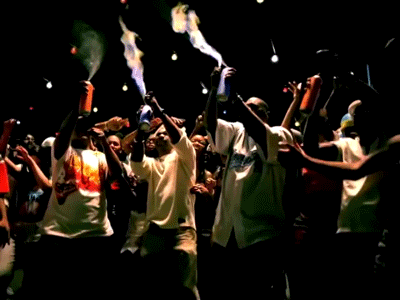
Some classic riddims, such as "Nanny Goat" and "Real Rock" both produced by Clement "Coxsone" Dodd, are essentially the accompaniment tracks of the original 1960s reggae songs with those names. Since the 1980s, however, riddims started to be originally composed by producers/beatmakers, who give the riddims original names and, typically, contract artists to voice over them. Thus, for example, "Diwali" is the name not of a song, but of a riddim created by Steven "Lenky" Marsden, subsequently used as the basis for several songs, such as Sean Paul's "Get Busy" and Bounty Killer's "Sufferer."
"Riddims are the primary musical building blocks of Jamaican popular songs.... At any given time, ten to fifteen riddims are widely used in dancehall recordings, but only two or three of these are the now ting (i.e., the latest riddims that everyone must record over if they want to get them played in the dance or on radio).... In dancehall performing, those whose timing is right on top of the rhythm are said to be riding di riddim.
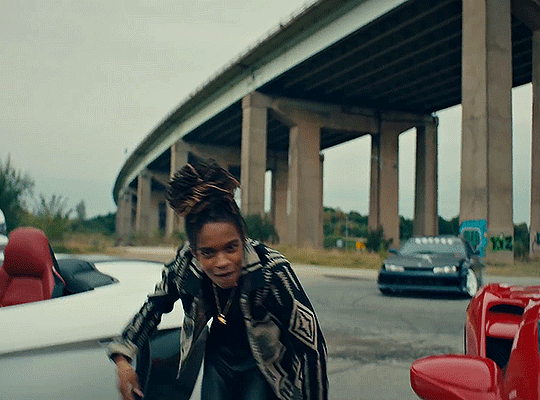
The bass culture of Jamaican sonic sensibilities is characterized with less emphasis on melody and large emphasis on the drum beats and low frequency bass vibrations to draw attention to the social grounding to the culture. These aspects of Jamaican music are expressed visually through the Dancehall choreography and its African inspired folk traditions, which emphasize earthly connection through flat-footed stamping and “bumper-grinding sexually explicit choreography, where the bass note is struck by the body itself—displaying its fecundity and celebrating its fertility”. This bass culture is also embodied sonically by the music's heartbeat, the bass lines often described as riddims, produced in the late 1960s and early 1970s. These riddims offer a sonic foundation on top of which different other sounds are incorporated to form innumerable versions.
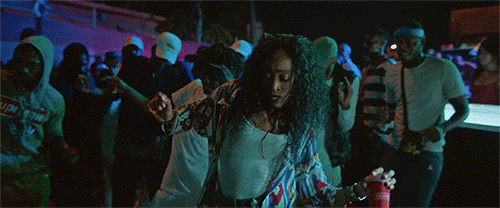
African in origin (see clave (rhythm) and bell pattern), riddims can generally be categorized into three types. One of the oldest types of riddim is the classical riddim providing roots reggae, dub, and lovers rock with instrumentals, such as Bam Bam, produced by Sly & Robbie. The second type is the ragga riddim backing raggamuffin and dancehall songs, such as the Juice riddim, produced by Richard "Shams" Browne. The third type is the digital riddim, such as Sleng Teng, Punaany Riddim & Duck Riddim produced by King Jammy.
A number of riddims take their name and influence from African-Jamaican religious drumming such as the Kumina riddim, created in 2002 by Sly and Robbie, and Burru.

#african#afrakan#kemetic dreams#africans#brown skin#brownskin#afrakans#african culture#afrakan spirituality#african music#riddim#burru#african jamaican#jamaican#jamaica#jamaican music#rastafari#rasta#rastaman#rasta love#dancing rasta
27 notes
·
View notes
Text
What is Alt-Rock and its history
Hello, my name is Colin Williams and I have created this blog to talk about the wonders of the music genre that defines my life. I was initially introduced to it through my parents as they have listened to it on the radio ever since I was a little child. Alt-Rock is an ingenious subgenre to the classic rock n roll family of music, it’s inception was from bands trying to differentiate themselves from the mainstream style of rock while still keeping their roots. Instead of having heavy bass and drums that is the main focus in rock, alt-rock tends to lean towards the melody and having powerful meaningful vocals that brings the listeners along for a ride. In my opinion this change in focus is what makes the genre stand out from everything else, as the groove of the music is just so addicting that it’s hard not to like it.

The alt-rock genre began with underground bands within the 1970s, and it didn’t leave those basements until the 1990s when one of the best bands of their time, Nirvana, came onto the scene in 1987. It wasn’t just them, it also included heavy hitters like Green Day, Foo Fighters and Red Hot Chile Peppers. The all time classic “Smells Like Teen Spirit” by Nirvana is the international sensation that marked the start to the worldwide praise of Alternative Rock. With the popularity at the time no one thought the genre would disappear, but after a multitude of terrible events to all the top bands at the time which caused them to no longer perform the genre slowly faded from its high horse. There were still amazing bands at the time but they weren’t nearly as dominant as before. This is what I considered the dark era of this genre dominated by emo inspired music, by far my least favorite style. Mainly because the lyrics are a lot more monotone and there is way less character and personality being put in the music itself. As such, the genre had to evolve once again, this time they ventured even further from the original rock style, this ability to adapt is one of the most important aspects that lets the genre expand to so many other genres. One of the biggest stars to embrace this change is Twenty One Pilots, they used their incredible lyrical skills to mix hip hop, emo, rock, indie pop and reggae, they achieved an enormous amount of praise and earned two consecutive top five singles. A new age of Alt-Rock begins and with it comes lots of diversity on what the genre actually means. The 2010s is definitely this best era of this type of music and is where many of my favorite songs come from. This era is considered more like purely Alternative music as it's so different from the original rock style it was based off.
22 notes
·
View notes
Text
Ganja White Night and Tape B presents: Ganja Tape
It's electronic with drum & bass, and some EDM

Label: SubCarbon Records
Growing up in the small town of Mons, Belgium, the duo was in a way sheltered from the music industry of the United States, allowing them to create a unique sound of their own. With their musical roots ranging from early UK bass and reggae vibes, Ganja White Night has twisted together their influences and spit out something truly fresh and their own. After a decade-plus deep discography, Ganja White Night struck a chord with their 2016 Mr. Wobble LP release, cementing their iconic Wobble sound. Centered around the idea of creating their own mini animated universe, the duo teamed up with Ebo, a famous Belgian street artist, to bring their vision alive. With the debut of Wobble Master & LFO Requiem full animated music videos in 2016, the story of Mr. Wobble was born.

Subsequent albums – which continued to tell Mr. Wobble's adventurous tale through Ganja White Night's iconic Wobble sound – included The Origins, The One, Dark Wobble, and their most recent album, Unity. Their significant collaborations to date include bass-music powerhouses like Zeds Dead, Subtronics, Slander, Liquid Stranger, and long-time collaborator Boogie T. Drawing similarities to the visual aspect of the Gorillaz and their unique style of telling a story through their music, the duo plans to continue exploring their own universe.
Tape B, born Kemal Berk Alkanat, is a dynamic force in today's electronic music scene, merging the nostalgic vibes of old-school dubstep with contemporary bass music and hip-hop. Born in Turkey and raised in the US from the age of three, Tape B brings a distinctive sound that captivates with a blend of nostalgia and modernity, termed "Old School x New School." His musical journey began at the University of Central Florida, influenced by early 2000s hip-hop and electronic pioneers like UKF and The Glitch Mob. His career took a professional turn after a revelatory experience at the Lost Lands Music Festival in 2019. Tape B's rise to prominence was fueled by viral SoundCloud mixes and dynamic live performances, including his iconic "Yo, Tape B" tag, which has become a recognizable call throughout modern clubland and festivals. Achieving significant traction with remixes and original tracks, including the standout "Trippy Land" with Mersiv and Juicy J, Tape B has redefined expectations within bass music. As of 2024, Tape B achieved sellouts of every headline since December 2023, including rapid ticket sales at Denver's Mission Ballroom and New York's Great Hall.
instagram
His introduction of Tape B Block Parties in 2024, as recently showcased across Texas with two sold-out events, has brought classic and modern dubstep brilliance to the forefront, further cementing his influence in the scene. In August 2024, Tape B released a genre-blending collaboration with superstar producers��John Summit and Subtronics. Tape B remains a vibrant and influential figure in electronic music. His commitment to innovation, community, and joy through music continues to drive his rapidly ascending career.
2 notes
·
View notes
Text
Bass, Beats, and Beyond: How Hardstyle and Dubstep Keep the Heart of EDM Pumping
Ever wonder why certain beats make your heart race, your feet move, and your soul soar? The secret lies in the powerful pulse of genres like hardstyle and dubstep. These two EDM giants have more in common than their commanding basslines; they share an electrifying spirit that transcends dance floors and unites fans worldwide. From the underground rave scenes of Europe to the massive festival stages, the energy of hardstyle DJs and the creativity of dubstep DJs continue to shape the very essence of electronic dance music. Let’s explore how these genres not only survive but thrive in the ever-evolving world of EDM.
Hardstyle: The Soundtrack of Pure Adrenaline:

Imagine standing at the front of a festival crowd, surrounded by thousands of people, as a hardstyle DJ unleashes a pounding kick drum that you feel deep in your chest. This is the essence of hardstyle—a genre built on raw energy and an unyielding tempo. Born in the Netherlands, hardstyle combines euphoric melodies with fierce, driving beats that keep the crowd moving until the break of dawn. The music's relentless pace is matched only by the passion of its fans, who are drawn to its unique blend of aggression and harmony.
Artists like Headhunterz, Noisecontrollers, and Wildstylez have taken hardstyle to new heights, creating anthems that resonate with both seasoned ravers and newcomers alike. At events like Defqon.1 and Qlimax, the connection between the hardstyle DJs and their audience is almost spiritual—an unspoken understanding that this is more than just music; it’s a shared experience, a communal high that transcends beats per minute.
Dubstep: A Sonic Exploration of Darkness and Light:
On the other side of the spectrum, dubstep has carved out its own path in the EDM landscape, offering a sound that is simultaneously gritty and sublime. Originating in the underground clubs of South London, dubstep was born from experimentation, blending elements of garage, reggae, and drum and bass. The result? A genre defined by deep bass drops, syncopated rhythms, and an otherworldly atmosphere.
Dubstep DJs like Skream, Benga, and Rusko were among the first to explore these dark, atmospheric soundscapes, but it was artists like Skrillex and Excision who brought the genre into the global spotlight. Their heavy, aggressive style—often referred to as “brostep”—took the genre to new levels, captivating mainstream audiences while still staying true to its underground roots.
The Festival Phenomenon: Where Hardstyle Meets Dubstep:
The true magic happens when these genres collide on the festival stage. Events like Tomorrowland, EDC, and Ultra Music Festival have become playgrounds for both hardstyle DJs and dubstep DJs, creating an eclectic blend of sounds that keeps the crowd guessing and the energy high. It’s not uncommon to see a crowd headbanging to the bone-rattling drops of dubstep one minute and then jumping to the euphoric kicks of hardstyle the next.
Festivals have become cultural melting pots where genres intersect, and fans discover new sounds and artists. The crossover appeal is part of what keeps the EDM scene so vibrant—when a hardstyle DJ brings out a dubstep remix, or a dubstep DJ drops a hardstyle track, it creates a fusion that is as surprising as it is satisfying.
The Future: Boundless Creativity and Collaboration:
The future of EDM belongs to those who dare to innovate, and both hardstyle and dubstep are fertile grounds for experimentation. As new subgenres emerge and artists continue to push the boundaries, the lines between hardstyle, dubstep, and other EDM styles will likely blur even further. Artists like 4D4M are leading this charge, incorporating elements from both genres and beyond, proving that the spirit of EDM is one of endless creativity and boundless potential.
Whether you’re drawn to the heart-pounding intensity of hardstyle or the deep, dynamic sounds of dubstep, one thing is certain: both genres are here to stay. Together, they form the beating heart of EDM, a force that’s as unpredictable as it is unstoppable. So next time you find yourself lost in the music, remember—these aren’t just sounds. They’re stories, experiences, and most importantly, they’re yours to explore.
3 notes
·
View notes
Text
August 17! Today we celebrate Afrocostarican culture!
i always confuse black history month because for us it's in August and for the United States is on February(?) correct me if wrong!
So today i wanted to celebrate it by sharing some data with you, note the information i'm about to display is from when i was a history student in 2022. Information may vary,have changed or anything else! Also i'm kinda bad with dates,im really sorry so im just putting like general time lapses.
Afrocostarican poblation started in Limon,the UFCO(United Fruit Company) was looking for people who could work on the heat and complicated conditions of Limon(today is very modern but back then think of it like an amazingly hot and humind jungle with tons of snakes) many were brought to work from people from the capital to immigrants from italy and China but those who stayed were the Jamaican people.
The workers were free which meant they were no longer slaves this by no means their stay here was made easy, racism and discrimation were and still are rampant angaist this poblation. It came to the point that Limon's citizen weren't recognizes as such until late 1900.Their ID starts with a 7 to signify the 7'nth province to join the republic of Costa Rica.
They have their own set of dialects Patua(Criolle Patois) is what they are most known for but if i rememeber well , english is actually the most common.
Cuisine is also greatly influenced by jamaican heritage instead of "rice and peas" we have rice and beans, which is delish is made with coconut milk,ginger,thyme and panama pepper and served normally with meat(It used to be turtle meat!). Pan bon also with ginger , Pati a savory spicy Pastry and my favorite Plantinta(abreviattion of Platain Tart) which is a sweet plantain pastry.
Music wise there is a own variation of Calypso, Limons Calypso. I'm not a music student and can not dissect this topic well but i do know reggae and jamaican ska were great inspirations for this genre of music. If you are looking to, you can listen to Walter Ferguson the emblem of Costa Rican Calypso.
And lastly a bittersweet data, from our understanding the plan wasn't to stay and make roots here, it was always was the plan to eventually return to Jamaica or for some Africa.

To which the Black Star Line was created but it never fullfield it's prooupose. It was burned in 2016 but has been rebuild to sme degree. It's closed too so sadly,no museum.
This were snippets of afrocostarican history ,this was what i learned in class and thefore not the best approach to it since im myself i'm not afrocostarican but i still tougth important and interesting to share.
4 notes
·
View notes
Text

Various - Rastafari (The Dreads Enter Babylon 1955-83) (2015)
A1 Count Ossie & The Rasta Family - Africa We Want Fe Go 1:27 A2 Johnny Clarke - None Shall Escape The Judgement 3:37 A3 Laurel Aitken - Haile Selassie 3:14 A4 Count Ossie & The Mystic Revelation Of Rastafari - Tales Of Mozambique 5:37 A5 Ras Michael & The Sons Of Negus - Booma Yeah 5:39
B1 Mutabaruka - Say 1:13 B2 Bongo Herman & Jah Lloyd - African Drums 3:32 B3 Ashanti Roy - Hail The Words Of Jah 3:49 B4 Count Ossie & The Mystic Revelation Of Rastafari - Sam's Intro 3:36 B5 Bongo Herman, Les & Bunnyv - Salaam 3:05
C1 Winston & Ansell - Zion I 3:44 C2 Techniques All Stars - Zion I Version 3:21 C3 Lord Lebby & The Jamaican Calypsonians - Ethiopia 2:59 C4 Count Ossie & Leslie Butler - Soul Drums 2:47 C5 The Heaven Singers - Rasta Dreadlocks 3:02 C6 Rod Taylor - His Imperial Majesty 3:12
D1 QQ - Betta Must Come 3:48 D2 Earth & Stone – Jah Will Cut You Down 3:22 D3 Count Ossie & The Mystic Revelation Of Rastafari - Narration 9:03 D4 Ronald Downer & Count Ossie - A Ju Ju Wa 3:34
Genre: Reggae Style: Roots Reggae, Dub
3 notes
·
View notes
Text
THE ROCKET-LIKE RISE OF LEE SCRATCH PERRY INTO THE CONTEMPORARY ART WORLD
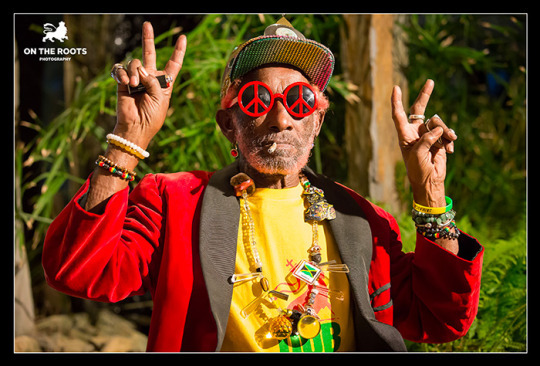
© Reggae.fr / On The Roots Kevin Buret - 2016.
Lee Perry: A Pop Artist
Altogether dancer, singer, musician, producer, eccentric, visionary, shaman and genius, Lee “Scratch” Perry is to Jamaican music, some would say, what Sun Ra is to free jazz, George Clinton to funk or Salvador Dali to painting. Born in 1936, in the small town of Kendal in Jamaica, Lee “Scratch” Perry participated in a concrete way in each of the important stages of the history of Jamaican music. A true pillar of reggae and dub, his innovations have left their mark on many other musical genres around the world, including: US rap; UK punk, jungle, ambient and trip-hop; Japanese electronic music; without forgetting European techno and avant-garde music. Today, Lee Perry is no longer of this world, in the flesh at least. He died late August 2021 at the age of 85. Nevertheless, his name unquestionably stays in vogue. It is still on the lips of pop stars like the Rolling Stones, The Orb, The Roots and Major Lazer, and we can also gradually hear it spreading in the contemporary art world.
The Black Ark: Sound and Image
Lee Perry always evolved into a very personal visual universe, starting with his legendary home recording studio, the Black Ark, at the origin of the most innovative sounds of the second half of the 1970s in Jamaica. Originally thought to be a sort of sanctuary for Rastafarians, the Black Ark was a very confusing place, whose walls were covered in cryptic inscriptions and floors served as dumping grounds for installations and other DIY projects, all of them being zanier than the next – a sculpture was even embedded inside one of the walls, says his ex-wife, Pauline Morrison, in People Funny Boy written by David Katz (2000: 324).

© Adrian Boot, circa 1977/ 1979. Part of JKD’s private photo collection.
This Baroque environment was part of the eccentric personality of the genius producer, embodied in an increasingly extravagant look and outfits over the ages: during his final years, he used to dye his hair and beard yellow, green of even pink, and he was decked out in completely fantastical clothes, personalised with pins and other fanciful objects. And when he was not wearing his famous golden baseball cap, adorned with glittering CDs, badges or religious illustrations, he was wearing a Native American feathered war bonnet or a wizard hat.

© Lee Scratch Perry painting in his studio in Switzerland (Blue Ark), 2018. Photo: Lorenzo Bernet. Courtesy: The Visual Estate of Lee Scratch Perry / suns.works.

© Lee Scratch Perry wearing his wizard hat in his studio in Switzerland (Blue Ark), 2019. Photo: Lorenzo Bernet. Courtesy: The Visual Estate of Lee Scratch Perry / suns.works.
It is more than clear Lee “Scratch” Perry was an artist with a capital A, a complete, total, full-time artist who did not switch to Rainford Hugh Perry (his real name) in private and who did not lock himself into a single box: the one of music. He did not play a role, he lived through his art full-time and was attracted as much to sounds as to visuals. Indeed, the latter played a significant role in his galaxy, in his symbolism, in his perception of the world. According to Perry himself, the image was the preferred channel for conveying messages (often subliminal), it was therefore necessary for him to be wary of them and to be able to reappropriate them. In some way, it can enable us to understand his involvement (conscious or unconscious) in the visual arts, which by the way was not recent. Indeed, reading his brilliant biography written by David Katz, we can easily realize that Perry had always been interested in his physical and cultural environment, the objects that surrounded him as well as the pop culture into which he loved to dig.
Even in the late 1950s, long before he began his musical career, when he worked in construction in Negril and drove bulldozers, Perry focused his attention on the noises associated with construction work and the energies of machines as they came into conflict with nature, one can read in People Funny Boy. He even reported an almost supernatural experience, resulting in his departure from this seaside resort located at the far western part of Jamaica to the capital Kingston in the early 1960s: “I get an overload from throwing stones down there for maybe two weeks. I started making positive connection with stones, by throwing stones to stones I start to hear sounds. When the stones clash I hear the thunder clash, and I hear lightening flash, and I hear words, and I don’t know where the words them coming from. These words send me to King-stone: to Kingston” (2000: 8).
Until the end of his life, stones occupied a pre-eminent place in his resolutely mystical universe. He regularly collected them, piled them up, carried them to various places, and even cooked them in a pot on the fire. In the late 1970s, that is precisely what happened, says Pauline Morrison, in their home in Washington Gardens, Kingston, which also housed his legendary recording studio.
“Pauline has claimed she was preparing a meal one afternoon when she noticed an odd smell coming from the kitchen. When she checked the pot, she found that Scratch had emptied the simmering contents into the mud of the yard, substituting a pan full of rocks in their place on the fire” (2000: 324). “If you see our house, this guy write all kind of shit on the wall, on the fence…” (2000: 323). And the Jamaican singer, Vicky Nelson, added, “my foot would be in paint, I would get rocks and all those nature things” (2000: 345).
As Pauline Morrison and Vicky Nelson suggest, Lee Perry also paid a great importance to writing and painting at the time of Black Ark. We must indeed go back very far in time to understand the links he developed with the visual arts and everything encompassed by this generic term: calligraphy, graffiti, assemblages, collages, installations, and painting among others. In short, everything that would make up his artistic inventory alongside his music. Lee “Scratch” Perry had always been a compulsive sketcher and graffiti artist, feeling a certain need to fill, if not to say overload, empty surfaces. From the end of the 1970s onwards, he even seemed to pay as much attention to the decoration of his studio as to musical production at times.
"Jean-Michel Basquiat himself called him a significant source of inspiration for his paintings"
Moreover, it is not surprising that at that time Lee Perry also commissioned art from Rastafarian artist Jah Wise to decorate the Black Ark. Indeed, he had the walls surrounding the studio decorated with huge, multicoloured murals painted by Robert Van Campbell aka Jah Wise. A portrait of Haile Selassie was placed just above the door so that all would have to ‘bow’ to Jah upon entering or leaving; to the left of his head was Selassie in his feline form as the Conquering Lion of Judah. Another wall had a life-size mural of the Super Ape, tree and spliff in hand, while the inside of the studio depicted African ancestors in chains and Rastafarian tri-colour flags. As time passed, such images would be altered and re-cast as Perry sought to express different concepts; like the music that was coming from inside the studio, its illustrated walls would seldom remain static. He also erected a sign with a ‘Management Order’ by the front gate, proclaiming that the premises included the site of a private house where women and children lived; all who sought to enter were to wait for official permission and once inside, were to refrain from using indecent language. (In People Funny Boy, French edition, 2012: 476-477).
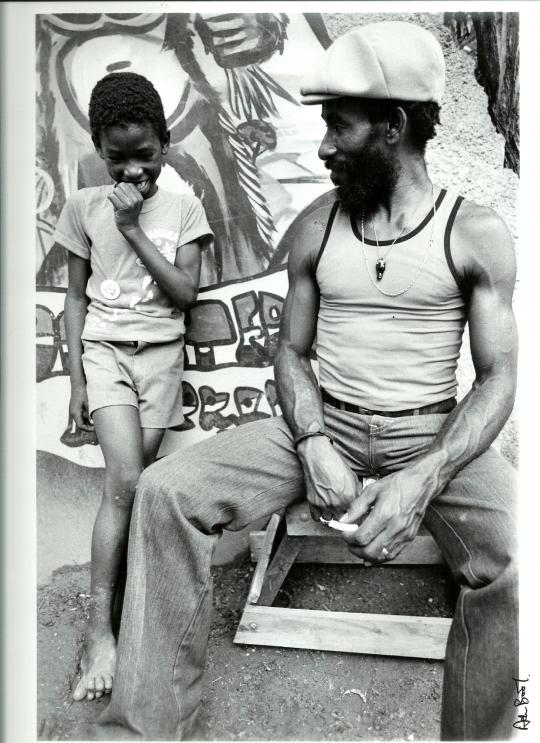
© Adrian Boot, 1978. Lee Perry and his son, Mark (aka Omar), at the Black Ark. In the background there is a glimpse of the “Super Ape” painting done by Jah Wise. Part of JKD’s private photo collection.
youtube
Lee “Scratch” Perry outside Black Ark Studios, Jamaica, 1977, premium footage from the Don Letts Archive available on YouTube.
All things considered, Lee Perry’s artistic source of creation originated far away back in time and widely developed during the seething cultural period of the Black Ark. Back in the 1970s, Lee Perry was already considering himself as a multi-disciplinary Artist and was already in contact with avant-garde people not only from Jamaica but also from England (Don Letts, John Lydon from the Sex Pistols, The Clash etc.).
After the Black Ark was destroyed by fire on one morning in the summer of 1983, Lee Perry experienced a very long period of exile, first in England, then in Switzerland where he moved out at the end of the 1980s with his new and last wife, a sultry queen of the Zurich nightlife, born Mireille Ruegg, only daughter of a couple of Swiss restaurateurs, who would become his manager. It was then that he started to show more and more interest in art, in a more professional way shall we say, the collections of four-handed paintings executed with British visual artist, Peter Harris, first between 2007 and 2009, then between 2014 and 2015, constituting a very good illustration of the extent of his pictorial work.
The Meeting with British Visual Artist Peter Harris
“How does a 40-year-old white British artist meet up with a 70-year-old black shaman from Jamaica and make a real connection? I am not a Rastafarian black man from the ghettos of Trench Town, I am a lower middle class Catholic son of an absent submariner father who moved from place to place and, as a consequence, has no ‘roots’ to speak of. This has led to a lifetime of what I suspect will be an unachievable search for home. I have lived through a series of popular culture ‘father figures’ who have been inspirational guides such as Bob Dylan, Francis Bacon, Johnny Rotten and Picasso, and Lee is one I’ve been lucky enough to meet in person. […] Lee’s experience and understanding - or “overstanding” - of Babylon is very different to my version of it. Lee’s version of Babylon might come from the Rasta’s view of western society as being corrupt, a world of ‘politricks’ and oppressors of Rastafarians. My version of Babylon is also about a society that oppresses our lives, but it is more about the unrelenting trajectory of existence. It might go something like this: birth, school, dreams, peer pressure, music, drugs for fun, student loans, love, jobs, depression, pressure, holidays, insecurity, mortgage, drugs for escaping, children, stress, peer pressure, cars, responsibilities, doubts, reality, panic attacks, bills, new clothes. In it but not of it, pets, vet bills, gym, mid-life crisis, new haircuts, hair loss, beer bellies, guilt, cigarettes, alcohol, food, cancer, medicine, pensions, fear, death” (interview conducted with Peter Harris by JKD, 2014).
In February 2005, Lee “Scratch” Perry responded positively to a request from Peter Harris who wanted him to be in a film he was working on, called Higher Powers. “I wanted different sorts of people who represented different kinds of higher powers,” Harris explains, “almost archetypal people. It might be a powerful gangster outside the law or a police chief, to someone with a spiritual higher power, or someone who totally doesn’t believe in higher powers. For the creative higher powers, or the visionary people, I thought of Ken Russell and Lee Perry” (2012: 898).
The concept was an appealing one for Perry, so permission was granted for Harris to film him at home on February 14th. The British visual artist interviewed him on various themes such as: destiny, faith, redemption, luck, love, doubt, etc. He then returned to London to edit the results. Subsequently, Peter Harris planned further filming sessions with Perry for the same film project. On October 1, 2007, Peter Harris' film, Higher Powers, was screened for the first time at the Lüneburg Art Hall in Germany. Perry appeared in the company of such controversial personalities as former gangster Dave Courtney, gay rights activist Peter Tatchell, Conservative politician Boris Johnson, Reverend Joanna Jepson (who has campaigned against the use of abortion for “eugenic reasons”), paranormal spoon-bender Uri Geller, Tibetan Buddhist monk Akong Tulku Rinpoche, and conspiracy theorist David Icke (2012: 910). Some years earlier, Harris had approached performers such as David Bowie, Siouxsie Sioux and members of the Stranglers, for ideas that he could turn into paintings; with a similar concept in mind, Harris returned to Switzerland in November 2007 to make a series of collaborative drawings with Lee Perry, ultimately inducting Perry into the world of fine arts.
“I’d done a Self-Portraits by Proxy series before,” Harris explains, “in which every person who had affected my life and influenced me, I asked for an idea, and then made that idea into a painting, but with Lee, it was a bit different. I called him up and said, ‘I’ve got these themes from the film, and I want you to give me the first image that comes into your head’; I’d say, ‘Luck,’ or whatever, and he would come up with some mad image, and I’d make it a drawing. Then I took all the drawings to his place in Switzerland, and he said we should cut them up; he was remixing them, like a record, taking something from one drawing and placing it with another, and it was more like a ceremony, or an Obeah ritual, so he spent a lot of time trying on different hats and costumes, as if he was getting into character. We started work at seven, and worked right through till four in the morning, and he had one CD that was just on repeat the whole time” (2012: 911).
On September 10th, Perry performed a special live dub set at London’s Tabernacle, with Adrian Sherwood at the mixing desk and live video animation behind him, as the climax of the “Higher Powers” art exhibition arranged by Peter Harris, which showcased the drawings the pair had produced in 2007, as well as a number of collaborative paintings they made together in Switzerland on August 15th 2009. The artwork dealt with typical Perry themes, such as social injustice, religious dogma, the unequal distribution of wealth, sex, and personal vengeance; some of the paintings bore the man’s handprints and footprints as well, while both paintings and drawings were marked by Perry’s declamatory graffiti (2012: 920). Images of the painting sessions carried out jointly by Peter Harris and Lee Perry in 2007 and 2009 as well as footages from the Tabernacle exhibition are viewable in the documentary, Lee Scratch Perry's Vision of Paradise, directed by Volker Schaner in 2015, an excellent film which also retraces the unusual trajectory of Lee Perry and clearly reflects the great part that art played in his daily life.
youtube
Lee Scratch Perry’s Vision of Paradise by Volker Schaner.
And as for the hundred works of art that the two artists made together between 2014 and 2015, they draw their inspiration from the Bible, from the Book of Revelation in particular.“With its tales of evil deeds, redemption and the apocalypse. It is rich in imagery, metaphor and parables. A parable is not a literal thing. It would not make sense to our modern minds, informed by readily available facts, to take it so. Language and visual language are vehicles for getting at some ‘truth’ as truth is often inexpressible” (interview conducted with Peter Harris by JKD, 2014).
This meeting with Peter Harris was clearly a step forward for Lee Perry into the world of contemporary art.

“Ja Pay” © Peter Harris and Lee “Scratch” Perry, biro pen and permanent marker pen on paper, 42 x 42 cm, 2007.
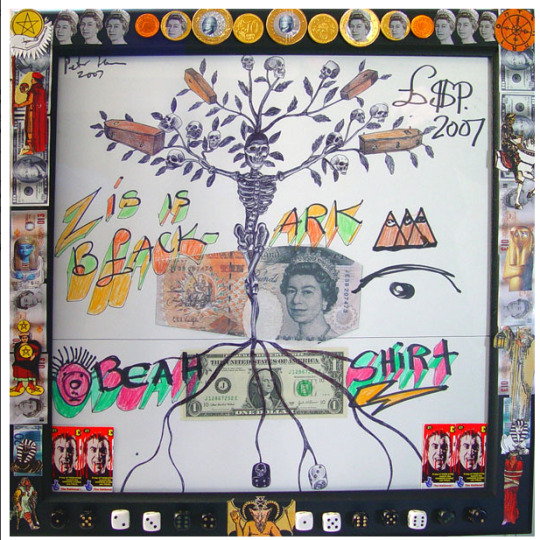
“Zis Is Black Ark” © Peter Harris and Lee “Scratch” Perry, collage, biro and pencil on paper, 42 x 42 cm, 2007.

“Judgement Com Yow” © Peter Harris and Lee “Scratch” Perry, marker pen, oil, acrylic paint on canvas, 123 x 109 cm, 2009.

“Super Ape” © Peter Harris and Lee “Scratch” Perry, biro pen, marker pen, felt tip and gold leaf paint on paper, 30 x 42 cm, 2014-2015.

“Super Man in Space” © Peter Harris and Lee “Scratch” Perry, biro pen, marker pen, felt tip and gold leaf paint on paper, 30 x 42 cm, 2014-2015.
The Rise of Lee Perry into the Contemporary Art World
A contemporary artist status confirmed by his induction into the Pantheon of sculptures made by Xavier Veilhan - using a 3D scanner - and held simultaneously in New York and Paris in the spring of 2015. During this double exhibition organised around music and simply named “Music”, the French visual artist wanted to pay tribute to the great music producers who had been shaping the soundtrack of our time, including Philippe Zdar, Pharrell Williams, Quincy Jones, Daft Punk, Rick Rubin, Brian Eno and Lee “Scratch” Perry. The latter therefore appeared in this impressive list of geniuses (around twenty in total), whose collectors are now snapping up statues made from a range of varied materials (from wood to metal through polyurethane resin).
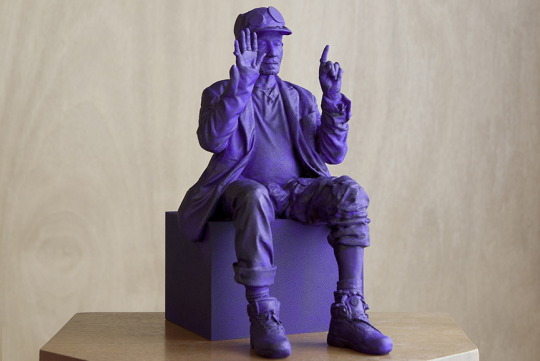
“Lee Scratch Perry”, © Xavier Veilhan, “Music” exhibition, aluminium-filled polyurethane resin, plywood, acrylic paint, varnish, 122,5 x 62 x 86 cm, 2015.
What followed was a portrait (on paper this time) dedicated to him by the monthly art French magazine, Beaux-Arts, in 2017, on the occasion of the exhibition “Jamaica Jamaica!” held at the Paris Philharmonic (April 4-August 13, 2017), where the above-mentioned statue created by Xavier Veilhan was moreover exhibited.
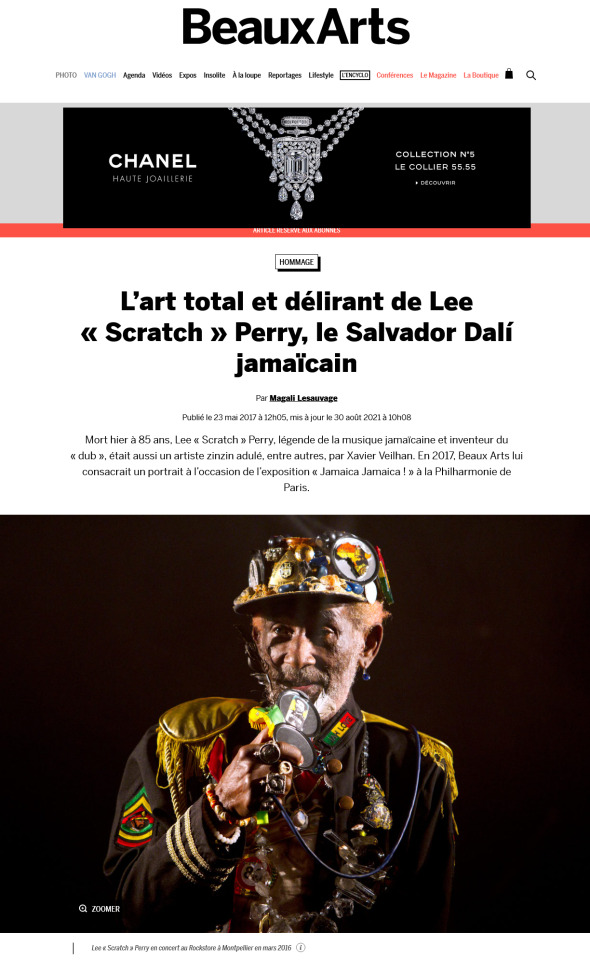
© article published on 23 May 2017 by Magali Lesauvage in Beaux-Arts.
Lee Perry made the front cover of other art magazines, such as the Italian biannual, Kaleidoscope, in 2020-2021.
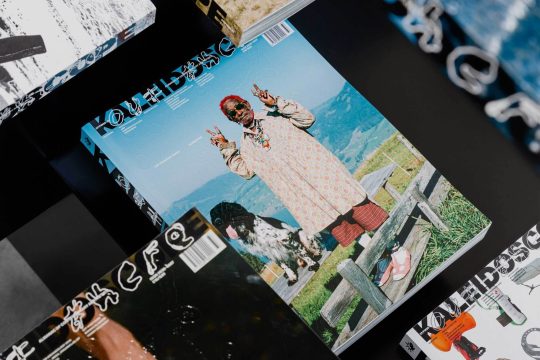
© Kaleidoscope, number 37, 2020-2021.
Finally, alongside all this, Lee Perry's visual artworks have been the subjects of numerous personal and group exhibitions around the world, starting with his very first solo exhibition held at the Californian gallery Dem Passwords from November 13 to December 11, 2010 under the name “Secret Education”.

© Dem Passwords, « Secret Education » exhibition, 2010.
Three other solo exhibitions were organised by this same gallery in 2013 (“Repent Americans” from April 20 to June 15), 2014 (“The Death of Baphomet” from August 29 to October 11) and 2016 (“Judgment Repentance God Order” from June 16 to July 30).
"these many art exhibitions around the world have coincided with the new curatorial team responsible for the visual estate of Lee “Scratch” Perry and headed by Lorenzo Bernet (...) this new, fresh and dynamic curatorial team seems to come up with creative and innovative ideas"
In that same year, Lee Perry also did an art show in New York, from June 29 to July 29, 2016 as part of a collective exhibition entitled “A Being in the World” and held at Salon 94 on the lower east side of Manhattan. His pieces of work were thus exhibited alongside those of a very heterogeneous panel of artists, including the African-American self-taught artist and former slave, Bill Traylor (1854-1949), and Maia Ruth Lee (born in 1983 in South Korea).

© Dem Passwords, « Judgement Repentance God Order » exhibition, 2016.
Then, Lee Perry multiplied international shows: at the Swiss Institute in New York in 2019, at the 2021 São Paulo Bienal, at the Museum of Contemporary Art of Rome in 2022, and at the Cabinet Gallery in London as well as at the 2023 Art Cologne international art fair, just to name a few. In total, Lee Perry actively took part in no less than fifteen international exhibitions between 2016 and 2023, and almost half of them in the last couple of years, which is the guarantee of a rocket-like rise on the contemporary art scene. Regarding this latter point, it is crucial to emphasize that these many art exhibitions around the world have coincided with the new curatorial team responsible for the visual estate of Lee “Scratch” Perry and headed by Lorenzo Bernet, a Zurich-based gallerist, curator and art dealer who is also the man behind the suns.works gallery. Therefore, it might be no exaggeration to say that this art world rocket rise relates to this new, fresh and dynamic curatorial team that seems to come up with creative and innovative ideas.

“Flood Sun” © Lee Scratch Perry, collage, markers and acrylic on wooden board, 60 x 100 cm, 2020. Courtesy: The Visual Estate of Lee Scratch Perry / suns.works.
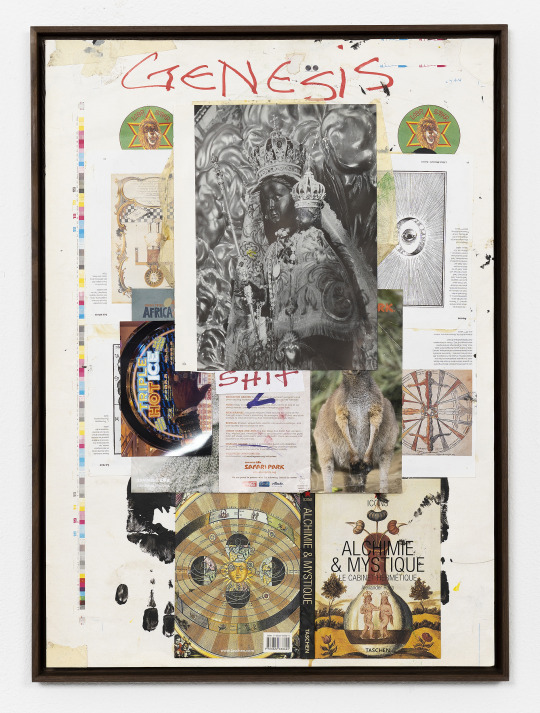
“Genesis” © Lee Scratch Perry, collage and acrylic on paper, 70 x 50 cm, 2020. Courtesy: The Visual Estate of Lee Scratch Perry / suns.works.

“Pisces and Aries (Yin Yang)” © Lee Scratch Perry, collage and acrylic on canvas, 170 x 140 cm, 2020. Courtesy: The Visual Estate of Lee Scratch Perry / suns.works.
It is also important to underline the presence of some of his drawings, paintings, collages and other installations in the collections of art aficionados like Sir Raymond Douglas Davies aka Ray Davies (former songwriter and lead vocalist for the legendary British rock band the Kinks), English record producer Adrian Sherwood (Coldcut, Depeche Mode, Primal Scream, Sinéad O'Connor, Lee “Scratch” Perry, Dennis Bovell), Mexican producer, remixer and composer Camilo Lara, and the British artist couple formed by Tim Noble and Sue Webster, as well as prestigious institutions such as the Bonnefanten Museum in Maastricht (NL). Others should soon be included in the permanent collections of the National Gallery of Jamaica as well as the Smithsonian Institution in Washington which currently investigates, along with the National Museum of African American History and Culture, Afrofuturist expression through art, music, and activism among others: an exhibition (March 23, 2023 – August 18, 2024) in which Lee “Scratch” Perry appears next to avant-garde jazz legend Sun Ra and the leader of African American Funkadelic style George Clinton - the threesome being tied to raw, original and pioneering Black aesthetic forms. And again, one owes this real tour de force to the new curatorial team headed by Lorenzo Bernet!
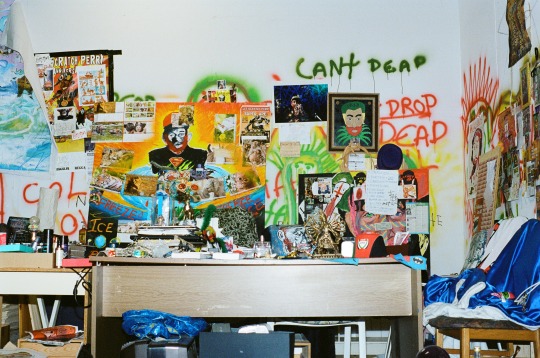
“Blue Ark (studio view)” © Lee Scratch Perry, 2016-2021. Photo: Camille Spiller. Courtesy: The Visual Estate of Lee Scratch Perry / suns.works.
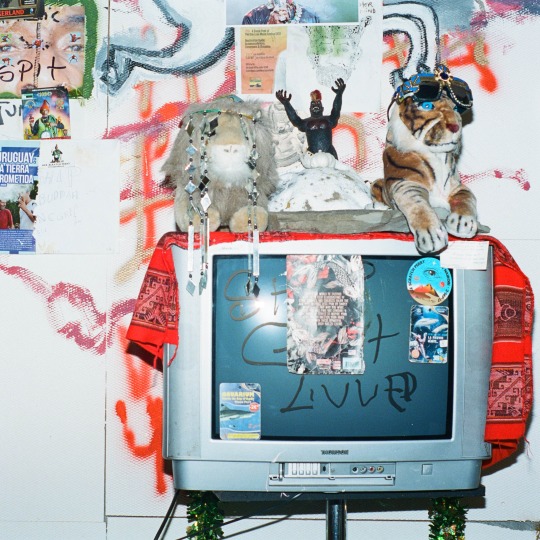
“Blue Ark with TV Sculpture (studio view)” © Lee Scratch Perry, 2016-2021. Photo: Camille Spiller. Courtesy: The Visual Estate of Lee Scratch Perry / suns.works.

“Blue Ark (studio view)” © Lee Scratch Perry, 2016-2021. Photo: Claude Barrault. Courtesy: The Visual Estate of Lee Scratch Perry / suns.works.
Last but not least, the resale of some of his artworks at auctions needs to be mentioned too, let alone the fact that Jean-Michel Basquiat himself called him a significant source of inspiration for his paintings, according to multi-disciplinary artist Lee Jaffe as well as the Gagosian Quarterly (Winter 2021 Issue).
A whole set of signals which suggests a more than bright future for Lee “Scratch” Perry in the modern and contemporary art world.

“Vanity Struck Me in My Tooth”, © Lee Jaffe in collaboration with Jean-Michel Basquiat, acrylic on Cibachrome print, 203 x 122 cm, 1983.

“Avenge” © Peter Harris and Lee “Scratch” Perry, marker pen, oil, acrylic paint on canvas, 124 x 95 cm, 2009. This work of art has been bought by Adrian Sherwood; it can be seen in the video below shot in 2022 in the deck-out living room of the producer.
youtube
Horace Andy : Tiny Desk (Home) Concert.
Books :
People Funny Boy: The Genius of Lee “Scratch” Perry, David Katz, 2000, Canongate Books, 538 pages.
Lee “Scratch” Perry: People Funny Boy, David Katz, 2012, Camion Blanc, 990 pages (French edition).
People Funny Boy: The Genius of Lee “Scratch” Perry, David Katz, 2021, Orion Publishing Group Limited, 688 pages (revised and expanded English edition).
Lee Scratch Perry: Black Ark, Andreas Koller & Lorenzo Bernet (Ed.), publication expected in July 2024, Edition Patrick Fey, 600 pages (500 illustrations).
Films :
Lee Scratch Perry’s Vision of Paradise, Volker Schaner, 2015, 100 min.
This article is the English, revised and expanded version of my paper published on Reggae.fr on 30 November 2023. © Jérémie Kroubo Dagnini (JKD).
#lee scratch perry#contemporary art#adrian sherwood#par reggae.fr#reggae#art#Youtube#art museum#collage art#installation art#jamaica#ray davies#the kinks#gagosian#basquiat#afrofuturism#afrofuturistic#artwork#drawings#installation#outside art#smithsonian#salvador dali#sun ra arkestra#george clinton
7 notes
·
View notes
Text
June 13th Playlist

We continue our salute to Black Music Month and focus on the genre of reggae music, a musical style that is dear to my heart and that I've had the pleasure of collecting and playing in clubs and on the radio for close to 40 years. I chose the above picture of Augustus Pablo, not because he made the playlist tonight, he didn't, but because we play a couple tracks from one of his collaborators and mentors, Herman Chin Loy. I had the privilege of seeing Augustus live in the late 80's, and it was a magical experience. Anyhow, roots reggae is the dominant style featured on the episode, with a smattering of ska and rocksteady in the mix as well. Hope it hits and you feel all right..
Side A Howling at the Moon-Hank Williams This Train-The Wailers Who Feels It, Knows It-The Wailers Simmer Down-The Wailers Fling it Gimme-The Gladiators Mr. Music-Culture New York City-Heptones International Farmer-Peter Broggs Hill Street Dub-Burning Spear
Side B Telegraph Dub-Burning Spear My Time-Gregory Issacs Rain from the Sky-Delroy Wilson My World is Empty Without You-Dennis Brown No More War-Beres No More Version-Herman Heavy Manners-Prince Far I Heavy Discipline-Prince Far I Jah Solid Rock-Israel Vibrations
2 notes
·
View notes
Text
Bob Marley & The Wailers – Chant Down Babylon
#Bob Marley & The Wailers#Confrontation#Chant Down Babylon#Format:#Vinyl#LP#Album#Country:#UK#Released:#May 23#1983#Genre:#Reggae#Style:#Roots Reggae#Rhythm & Blues#Jamaica
15 notes
·
View notes
Text
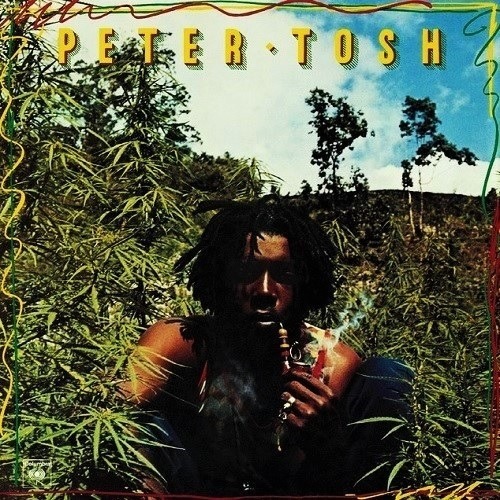
Daily Listening, Day #50 - February 19th, 2020
Album: Legalize It (Columbia, 1976)
Artist: Peter Tosh
Genre: Roots Reggae
Track Listing:
"Legalize It"
"Burial"
"Whatcha Gonna Do"
"No Sympathy"
"Why Must I Cry"
"Igziabeher (Let Jah Be Praised)"
"Ketchy Shuby"
"Till Your Well Runs Dry"
"Brand New Second Hand"
Favorite Song: "No Sympathy"
2 notes
·
View notes
Text
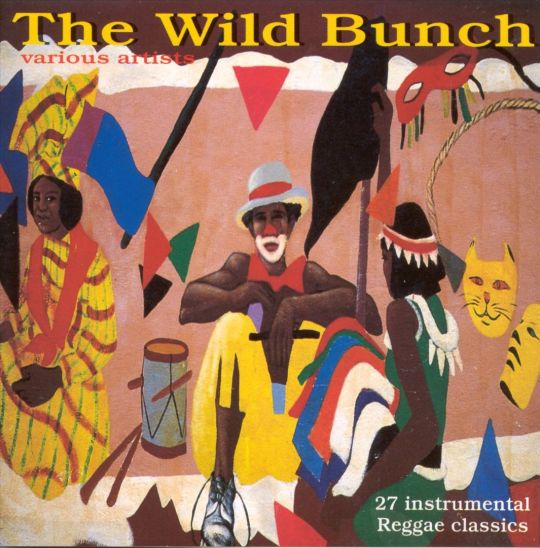

Today's compilation:
The Wild Bunch 1995 Reggae / Roots Reggae / Rocksteady / Dub
First off, let me just say that I am in total awe of this crop of reggae instrumentals from the 60s and 70s here. So much music since has come with so much more fuss and technological advancements, and yet an unscalable pile of the stuff that came out after this doesn't seem to come close to how good a bunch of these simple tunes still are. In a broad sense, all these songs' formulas are pretty simple, but they really still just manage to click so damn well 😌.
From this comp's liner notes:
During the past eight years, Trojan have pioneered the 'Revival' Reggae scene. Our re-issue programme has preserved some of the best vocals ever recorded in Jamaica, but with the emphasis being placed on some of the island's many talented singers in recent years, the musicians have tended to be ignored. This current release reverses that trend by turning the spotlight onto the 'players of instruments', and in so doing we pay tribute to Kingston's legendary session men.
Now, because nearly all of these are straight-up instrumentals, they all pretty much operate in the same way, and each of them seem to have one thing in common that ends up either making or breaking the tune: the lead instrument. Because reggae riddims are inherently repetitive and steady, if left alone, they will naturally get stale. So, it takes a good melody of some kind to be laid atop that riddim in order to lend the song some much needed variety. And in a whole lot of these 27 tunes, that ends up coming to remarkable fruition.
It's hard to even really know where to begin with this album since there's so much goodness to be found within it, but the thick, whistle-ringing improvisational organ of Lloyd Charmer's "Ling Tong Ting" is an absolutely terrific place to start. Then the JJ All Stars get topsy-turvy with the audio channels on "Memphis Underground," by sending the melodic leads exclusively and *very prominently* through the left, and 90% of the riddim through the right; Herman Marquis' "Tom's Version," whose intro I'm pretty sure I've heard sampled in at least one hip hop tune before (Wu-Tang, maybe? It's honestly driving me crazy that I can't put my finger on it), then follows by doing a wonderful job of harmonizing its organ and trumpet, yielding this fully warm and satisfying haze; the legendary Augustus Pablo, who singlehandedly managed to transform the melodica from a mere plaything for children into an instrument with serious gravitas, shows why on a rootsy piece of dub called "Great Pablo;" and then towards the end, we get a bit of a surprise with a piece of gospel-reggae that's actually not an instrumental: the Harry J All Stars "Holy Moses," which is aided by a small set of female singers whose deployment of soul harmonies reminds of the backup singing that can be found on a bunch of Bob Marley hits.
But the closing title tune by the Music Doctors may be both the most remarkable and most fun track of them all, for the simple fact that it uniquely trades its leads between—not things like guitars, horns, and organs—but just bass and drums. And the bassist just seems to carefreely play this laid-back and very recognizable piece of melody from The Jackson 5's "I Want You Back;" it's so good!
So, a phenomenal collection of rare Jamaican reggae instrumental classics here, from the genre's premier label itself, Trojan. Yesterday, I posted about an excellent metal cassette from 1985 that's also called The Wild Bunch, and given how good that that album was, I really didn't think that this one could outdo it, but it very much did!
Highlights:
Selwyn Baptiste - "Mo' Bay" Boris Gardiner - "Memories of Love" The Dynamites - "Phantom" Sound Dimension - "Soul Food" Lloyd Charmers - "Ling Tong Ting" The Aggrovators - "The Sniper" JJ All Stars - "Memphis Underground" Lynn Taitt & The Jets - "Love Me Forever" Herman Marquis - "Tom's Version" The Tennors - "Copy Me Donkey" Winston Wright - "Heads or Tails" Augustus Pablo - "Great Pablo" Harry J All Stars - "Holy Moses" Music Doctors - "Wild Bunch"
7 notes
·
View notes
Text
18/01/23 ~ NTS Radio ~ Ryuichi Sakamoto Special
For the past 2 months I've listened to every album, soundtrack, composition, live recording that Ryuichi Sakamoto has made. There have been a lot of tears. A lot of reflection on life, on mortality, on social harmony and the environment. A loooot of emotions have been felt.
All of this research has solidified my respect for Sakamoto as an artist. A true pioneer. A maestro. Condensing his career into 2 hours has been difficult, but I hope you enjoy the show and my notes.
~~~~~~~~~~~~~~~~~~~~~~~~~~~~~~~~
Ryuichi Sakamoto has released over 20 solo studio albums, 10+ live albums, several compilation albums, over 40 EPs and singles, and about 48 soundtracks.
1978 - Thousand Knives - Plastic Bamboo
Sakamoto’s first solo album, created with the help of Hideki Matsutake who was known as the 4th member of YMO. The album fused electronic music with traditional Japanese sounds whilst incorporating elements of modern classical and reggae.
On the album cover, from Taeko Onuki “I was told that the jacket he’s wearing was an Armani and chosen by Yukihiro. I had only known Sakamoto in jeans and rubber sandals and he said to me, “What do you think?!
2. 1980 - B-2 Unit - Riot in Lagos
Sakamoto’s “edgiest” album. B-2 Unit birthed Riot In Lagos which is said to be an early example of electro. Several electro and hip hop artists were influenced by the album, especially Riot In Lagos.
“Differencia" has, according to Fact, "relentless tumbling beats and a stabbing bass synth that foreshadows jungle by nearly a decade". Some tracks on the album also foreshadow genres such as IDM, broken beat, and industrial techno. For several tracks on the album, Sakamoto worked with Dennis Bovell, incorporating elements of afrobeat and dub.
Another recommended track: E-3A
3. 1981 - Left-Handed Dream / Hidari Ude No Yume - Kacha Kucha Nee
Sakamoto wanted to record an album rooted in pop and created Left-Handed Dream (or Hidari Ude No Yume), which displays a variety of global influences through the instruments used - marimba, didgeridu, traditional Japanese instruments such as the sho and hichiriki flutes. The album showcased Sakamoto’s ability to seamlessly combine Eastern and Western sounds, strengthened through collaborating with Talking Heads guitarist Adrian Belew & co-producing with Robin Scott.
Venezia would then become the Left Bank!
4. 1982 - Bamboo Houses
Sakamoto continues his long-standing collaboration with David Sylvian of Japan, Sylvian’s first solo project outside of the band. Featuring Steve Jansen on drums.
5. 1983 - Merry Christmas Mr Lawrence Soundtrack - Forbidden Colours
Sakamoto’s first film score, for Merry Christmas Mr Lawrence which he also starred in alongside David Bowie. David Sylvian contributed lyrics and vocals on Forbidden Colours, which became a hit and a vocal version of the main theme, Merry Christmas Mr. Lawrence. The soundtrack won a BAFTA Award for Best Film Music in 1984.
Another recommended track: Germination
6. 1984 - Ongaku Zukan - Etude
Ongaku Zukan was an experimental album with no deadline - created around Sakamoto’s incredibly busy schedule in 1983, which saw Yellow Magic Orchestra pause their group activities after an intense 8 years of recording and touring. Features from Hosono, Takahashi, Minako Yoshida and Tatsuro Yamashita.
Sakamoto recalls he got started on the album without having a clear direction for its content: "Making an album without a blueprint...... it's an adventure to see what happens like when you embark on a sea voyage without a compass or chart. If you follow a blueprint, you will be able to record efficiently and in a short period, but I removed all of that and made it that way."
Sakamoto likens this production method to "automatic writing", which is known as one of the methods of surrealism:
"I went into the studio and recorded what came out without any prejudice...... I made it as if in a kind of trance. It could be something classical, it could be pop. Regardless of style and unity, the major premise was to accept everything that was made, so we created a lot of songs."
7. 1985 - Esperanto - A Rain Song
Sakamoto’s 6th solo album, orginally composed for a performance by New York choreographer Molissa Fenley. An experiment with new sampler technology - apparently Sakamoto needed a huge computer to make this score.
Another recommended track: A Wongga Dance Song
8. 1986 - Futurista - GT
Futurista (未来派野郎, translates literally as "Futurist Bastard") was created as a response to the Futurist Movement - an artistic and social movement originated in Italy. Mid 80-s avant-garde synthpop perfection!
Sakamoto samples a lot throughout this album - G.T. samples “Legs” by Art of Noise.
9. 1986 - Illustrated Musical Encyclopedia - Field Work (ft. Thomas Dolby)
The reissued English titled version of Ongaku Zukan, intended for the international market. It combines about half of the tracks from the 1984 album with newer singles "Steppin' Into Asia" and "Field Work” ft. Thomas Dolby.
10. 1987 - Neo Geo - Risky ft. Iggy Pop
The term "neo geo", or "new world", is derived from Sakamoto himself as a way to describe worldwide musical diversity in regard to genre (similar to world music and world beat). Again, showcasing Sakamoto’s ability to combine Eastern and Western musical styles.
Bootsy Collins on bass!
11. 1987 - The Last Emperor Soundtrack - First Coronation
The soundtrack features 9 pieces composed by Sakamoto, 5 by David Byrne & 1 from Cong Su. The album won Best Original Score at the 1988 Academy Awards.
12. 1989 - Beauty - You Do Me
8th solo studio album, which sees his solo career begin to extend outside of Japan. Beauty is notable for its "collage of styles" that range from rock, techno, and classical to flamenco, African, and Japanese traditional, featuring a long list of collaborators.
In discussing whether music is narrative and illustrative or an abstract medium, Sakamoto said, "I have visions sometimes when I'm writing contemporary music, even when it's very logical. For example, for one of my songs on the album Beauty, I was always having visions of Amazonian rainforests, a little plane flying very low over the trees. Trees, trees, trees, and some birds. But the title of the song is 'Calling from Tokyo'".
13. 1991 - Heartbeat - Rap to the World
Sequel from Beauty, still collaging sounds from all over the world, this time in an eclectic upbeat fashion. You can hear the dance music influences throughout this album, which is enforced through the credits - notably Towa Tei and Satoshi Tomiie.
14. 1994 - Sweet Revenge - Same Dream, Same Destination
One of my least favourite Sakamoto albums - the strings are beautiful but a lot of the vocals miss for me. But this song + the cover is iconic! Maybe he was just gearing up for his next album, Smoochy.
The album title refers to Sakamoto’s wish to bring a sense of melody back to the “rhythm-obsessed pop-world”.
15. 1995 - Smoochy - A Day In The Park
An exploration of the old world meeting the future - Sakamoto combines Latin tinged sounds, jazz and the possibilities of the internet through electronic experimentation with an “listening” approach running throughout Smoochy.
16. 1996 - 1996 - Bibo no Aozora (Trio World Tour Live recording)
1996 contains a selection of Sakamoto's most popular compositions plus two new compositions, all arranged for a standard piano trio. The arrangement of "Bibo no Aozora" that appears on this album has appeared in several film and television projects.
A concert, called Ryuichi Sakamoto Trio World Tour, was organised in 1996. This concert was played at 6 venues in Japan, and the Bunkamura Orchard Hall concert was live streamed on August 28, 1996 on the Internet, and was one of the first concerts to be streamed.
17. 1997 - Discord - Salvation
Sakamoto’s first full length orchestral work, which sees him contrasting modern musical tools with traditional instruments. Amongst procrastination and self-imposed deadlines, Sakamoto wrote the four movements in Discord ("Grief," "Anger," "Prayer," "Salvation") in a month. He finished writing the last notes on the morning of the first rehearsal with the orchestra.
Salvation features spoken word contributions from Laurie Anderson, DAvid Byrne, Patti Smith and Banana Yoshimoto.
18. 1998 - BTTB (Back To the Basics) - Energy Flow
Sakamoto was stuck in a traffic jam and melody popped into his head. That melody would then become Opus - the opening track of his solo piano album, BTTB - Back To The Basics. BTTB & Discord see Sakamoto’s departure from his pop-tinged outputs as he returns to the piano.
19. 2002 - Elephantism - Great Africa
Elephantism stands out from the rest of Sakamoto’s discography as it’s his first venture into new-age, ambient sounds with elements of African musical styles, featuring field recordings.
Elephantism is a reflection of Sakamoto’s life ethos, where he strives for world peace. In his search for harmony, he turns to nature - specifically the elephant. “Elephantism is the state of being compassionate, loyal and loving towards family and friends, and being understanding and generous in attitude toward other clans; it means being big and expansive in your outlook on life, not small and mean; it means showing thoughtful consideration, wisdom and dignity when necessary, but in equal measure showing powerful expression and emotion, and being, yes, a little wild and passionate now and then!”
20. 2002 - Works I - CM - Old I (Suntory 1983)
Compilation of music written for various commercials (called CM in Japan), all works are from 1983 to 1984. Monopoly is a favourite (didn’t have enough time to include it in the show!)
21. 2004 - Chasm - Ngo/Bitmix
Sakamoto’s 15th solo studio album. Chasm is experimental, combining the paion with ambient and glitch programming. Features contributions from Hosno and Takahasi, under their Sketch Show alias.
22. 2005 - Insen - Avaol
Sakamoto and Alva Noto’s second studio album - their collaboration began in 2002. “Both explore the potential for interaction and tension between electronic and acoustic instrumentation”.
23. 2009 - Out of Noise - composition 0919
Sakamoto was one of a handful of concerned artists who took part in The Cape Farewell Project, where scientists joined with the creative community for a conference in Greenland to address and investigate global warming. During his stay in Greenland, Sakamoto made a number of field recordings that he incorporated into his album Out of Noise; the album is dominated by graceful, minimalist keyboard pieces punctuated by electronic noise, ambient sounds and bits of found voices.
24. 2017 - async - Zure
Sakamoto’s 19th studio album - his first one in 8 years since Out of Noise. It’s also his first full length solo record since recovering from throat cancer in 2015. During this 8 year “break” he felt uninspired with the composition process and focused on scoring films. Despite his recovery, Sakamoto thought that async would be his last album. "That’s why I tried to forget all the rules and forms, anything. I just wanted to put down just what I wanted to hear, just a sound or music, it doesn’t matter. This could be the last time."
He began making async in 2016 and completed it in 8 months.
Async is unusually textural, featuring both acoustic and electronic elements plus samples recordings readings and field recordings of city streets. Sakamoto’s worries of death seep into the album, which were influenced by his experience with cancer and the many earthquakes and tsunamis in Japan in 2011. “We were warned about how our civilisation is fragile and how the force of nature is great."
25. 2023 - 12 - 20220123
Maybe one of Sakamoto’s most moving albums.
His breath can heard throughout 12 like a metronome - keeping time, evoking the feeling of a warm embrace and making us are of how fleeting life is. It has a palpable level of intimacy to it, as if you’re in the room with him as he plays the piano.
~~~~~~~~~~~~~~~~~~~~~~~~~~~~~~~~
Ending on a few of my favourite Sakamoto quotes:
"I hate to divide the world -- East and West. Where is the edge? My music is much more melting."
"I want to be a citizen of the world. It sounds very hippie, but I like that."
20 notes
·
View notes
Text
MSDROPPINIT ♫ IN EVERY ASPECT ♫ (YOUTUBE CHANNEL)
Posted on 28 November 2023 in
This second YouTube channel managed by self-taught reggae enthusiast Debbie features digitised recordings and video footage of Jamaican and international deejays, artists, sound systems, and events in Jamaica, Canada, and the USA in genres ranging from reggae, ska, and dancehall to rocksteady, lovers rock, and classics. Some examples of featured content include the 2003 Sound Clash between Bass Odyssey, King Turbo, Rebel Tone, and Little Thunder, Louie Rankin & Brigadier Jerry (1986 Black Roots Sound), and Upsetter Hi Fi (1983 Regent Park). #blog#Canada#dancehall#diaspora#dub#history#jamaica#music#recordingstudio#reggae#socialmedia#soundsystem#technology#Toronto#USA#visual
#reggae#youtube#debbie dropit#msdroppinit#reggae music#debbiedropit#audio visual#world clash#dancehall
2 notes
·
View notes
Text
Roots Reggae - Uncover the Mesmerising Rhythms
Uncover the Mesmerising Rhythms of Roots Reggae Roots reggae is a genre of music that originated in Jamaica in the late 1960s and early 1970s. It is known for its deep bass lines, pulsating rhythms, conscious lyrics, and spiritual messages. The Origins Roots reggae evolved from earlier Jamaican music genres such as ska and rocksteady. It combined elements of African rhythms, American R&B, and…
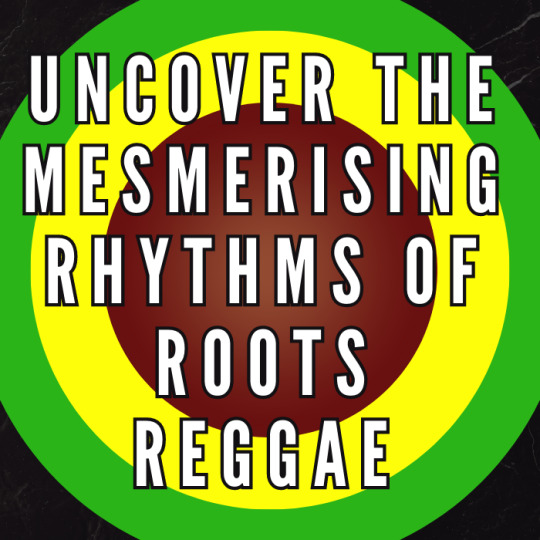
View On WordPress
7 notes
·
View notes